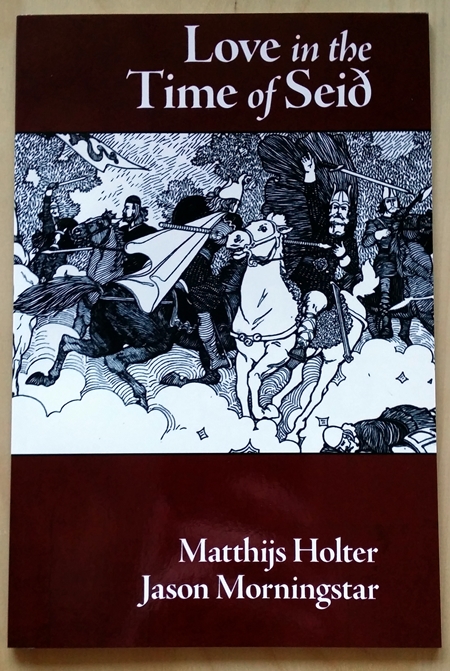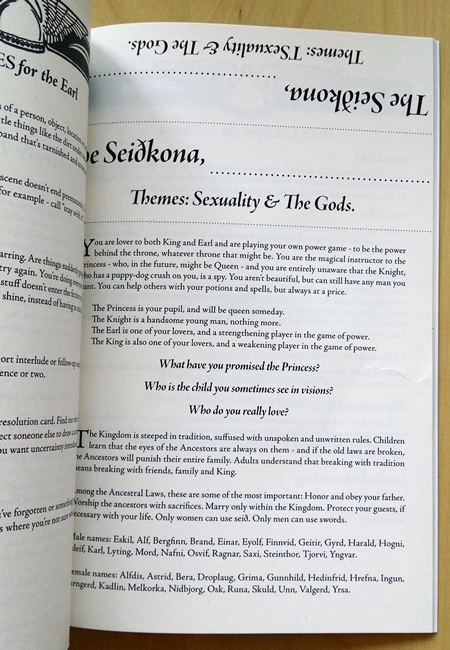At Go Play NW, I played a session of Love in the Time of Seið that I would rank among my top five gaming sessions of all time.
Designed by Matthijs Holter and Jason Morningstar, Love in the Time of Seið (the “ð” is pronounced like the “th” in “them,” as I understand it) is a GM-less story game for 3-5 players — though having played it with five, I highly recommend the full complement — requiring no prep and playable in a single session.

Seið is based on Matthijs’ Archipelago II. (Archipelago III, revised by Jason, is the newest version.) About half of this slender volume is stuff you’re supposed to copy and cut out for use in play — character sheets, resolution cards, and locations — so I recommend snagging the PDF, or both print and PDF.
The play aids print up just fine on regular paper, which is what I did for my go folder of zero-notice RPGs. The character sheets deserve special mention for their design, which includes a built-in table tent:

The game itself is a Norse-themed Shakespearean blood tragedy, a spiral of death, sex, and messy relationships, and it’s a thing of beauty.
Intimate dovetailing
Each character sheet has themes (e.g., sexuality and the gods for the seiðkona), a brief background, three questions to keep in mind (but not answer definitively until play begins), a background on the fictitious Scandinavian setting, and some thematically appropriate names on the front. On the back are a series of questions — things like “More details!” and “That might not be quite so easy!” — used to drive gameplay.
Seið plays out in a series of scenes, rotating around the table, which each scene spotlighting a single character (though often including several characters). When it’s your turn in the spotlight, you choose a location and, if it’s the first time that location has been used, also choose a version of the place to describe; each location card offers several options. You then frame the scene, rope in other players as needed, and you’re off.
What makes it tick so beautifully in play is that everyone has some common ground, and everyone is involved in every scene. The common ground is in the setting, which is collaboratively created using thematically appropriate locations, and the goal: the game ends when two characters have been removed from play (in our game, they were both dead).
The involvement comes from several sources. Folks in the scene are obviously involved, of course. But the player to the spotlight player’s left is also the Location Guide, inserting an event during the scene, and the player to her right is the Theme Guide, watching for ways the spotlight character’s themes can be incorporated into the scene. And on top of that, everyone at the table can interject with the game’s questions, working to make the scene even more amazing and driving the story towards a tragic finale.
The net result is that every character, and every player, is deeply and intricately dovetailed with every other character and player at the table. It’s a powerful and surprisingly intimate experience, one that depends on trust and a mutual willingness to hold one’s own ideas lightly and react to the fiction as it plays out.
The rush is intense
I found Love in the Time of Seið electrifying and deeply engaging. It took a lot of focus energy to play, in large part because you’re almost always “on” — which I love. In our session, everyone at the table brought their A game, the story and characters surprised us all, and afterwards I had that great combination GMing high/completely drained feeling that only comes from the best gaming sessions.
Love in the Time of Seið is a masterpiece of refined, effective game design, and a glorious blast to play, and I highly recommend it.

Blast! More money dredged from m’purse!
My work here is done. ;-)